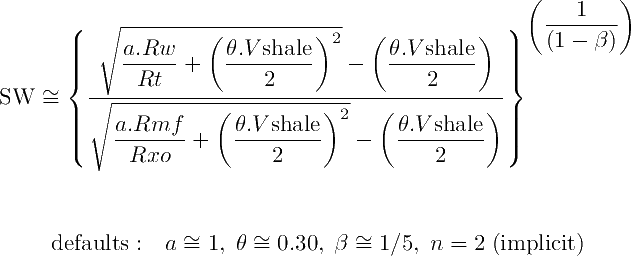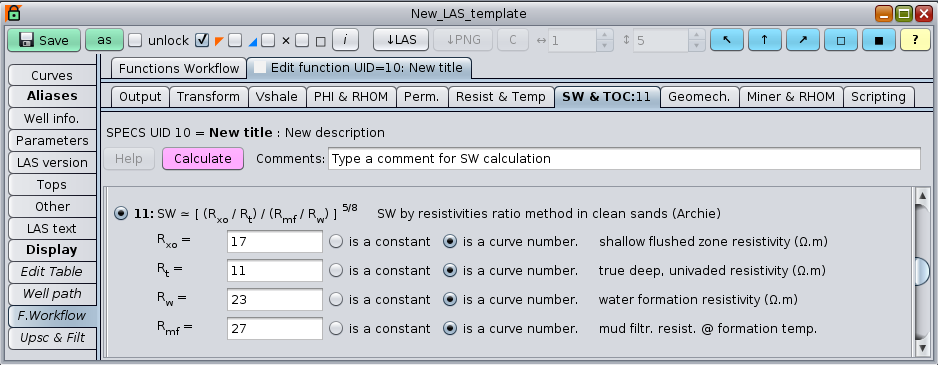
|
 Downloads
Downloads
|
 Prices
Prices
|
 Videos
Videos
|
GeolOil - The SW ratio method: Water Saturation from Flushed-Zone Rxo Resistivity
By: Oscar Gonzalez, GeolOil LLC. This paper was first published on April 2020 on the website geoloil.com
The SW ratio equation allows to coarsely estimate the uninvaded water saturation in clean reservoirs, without knowing the formation porosity and the Archie parameters a and m. Instead of porosity, it requires the flushed zone resistivity Rxo, and the mud filtrate resistivity Rmf converted to the reservoir temperature:

PROOF: (For the interested reader) The former equation is derived by applying the Archie equation for clean reservoirs —non shaly, non conductive matrix—, both in the non invaded zone (far beyond the zone invaded by the drilling mud), and in the zone invaded by the mud (close to the borehole wall):

The SW ratio equation presented above is useful when dealing with clean reservoirs. But how can we deal with moderately shaly reservoirs for which either it is not known its porosity or we don't want to use inaccurate porosity estimates? In this article —first published in this geoloil.com web-page on April 2020— we introduce a correction to deal with shaly reservoirs.
For this, we may try to replace the clean SW Archie equation with some SW equations that incorporate the effect of excess of conductivity due to the presence of clays in the shale. Classical candidates for such replacement are the Simandoux equation, the Indonesia equation, and the Fertl equation. It is the Fertl equation (which reduces to the Archie equation when Vshale=0 and n=2) the one that provides the easiest mathematical treatability:

Applying now the same algebraic steps depicted for the Archie SW ratio proof, we finally get our recommended general purpose equation, with a correction for shale content:

⚠
REMARKS:
Both the original Archie SW ratio equation, and our extension introduced above with a correction for VSH are appealing.
However, they require good quality data and a stable borehole to work, otherwise the results may be misleading:

The GeolOil Panel to compute Water Saturation from flushed zone resistivity

The figure above shows in a red curve SW_Rxo, the Water Saturation computed by the Archie ratio. Notice a good match beyond MD > 725 ft between the curve SW_Rxo, and the regular SW_Final curve computed by the Indonesia equation
✔ NOTE: The GLOG file work-flow for this log is available for download with the set of optional interpretation examples.

|
Related articles:
|
 GeolOil is listed by the official
SPWLA software directory
GeolOil is listed by the official
SPWLA software directory
| |



|
|
|
© 2012-2025 GeolOil LLC. Please link or refer us under Creative Commons License CC-by-ND |




 TRAINING
TRAINING

 PAPERS
PAPERS
 REFERENCES
REFERENCES
 GET IN TOUCH
GET IN TOUCH

